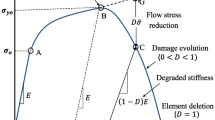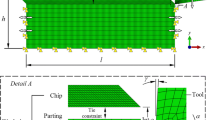Abstract
Titanium alloys have been attracting interest in aerospace industries because of their high strength-to-weight ratio. However, they are classified as difficult-to-machine materials due to poor tool life in machining processes. Cryogenic machining is a process that uses liquid nitrogen (LN2) as a coolant, and proposed as a method to enhance tool life in the present study. This paper presents a theoretical study to develop a predictive cutting force model for cryogenic machining of Ti-6Al-4V. A modified (in terms of cutting temperature) Johnson-Cook model that considers phase transformation, and a friction coefficient were used as input parameters for inclusion of the cryogenic cooling effect. The predictive cutting force model was validated based on an orthogonal cutting test. The predicted forces showed good agreement with the experimental data, with minimum and maximum error magnitudes of 1.9 and 17.7% for cutting force, and 0.3 and 32.8% for thrust force, respectively. Investigation of the effects of cryogenic cooling on the cutting force, micro-structure, surface integrity and burr height were conducted. The cutting force during cryogenic machining was increased compared to dry machining by a martensitic phase transformation of the work material. There was no effect of cooling condition on the surface roughness. The burr height under cryogenic conditions was decreased by 56.2 and 28.2% compared to the dry and wet conditions, respectively.
Similar content being viewed by others
References
Castellani C, Lindtner RA, Hausbrandt P, Tschegg E, Stanzl-Tschegg SE, Zanoni G, Beck S, Weinberg AM (2011) Bone–implant interface strength and osseointegration: biodegradable magnesium alloy versus standard titanium control. Acta Biomater 7(1):432–440. https://doi.org/10.1016/j.actbio.2010.08.020
Long M, Rack H (1998) Titanium alloys in total joint replacement—a materials science perspective. Biomaterials 19(18):1621–1639. https://doi.org/10.1016/S0142-9612(97)00146-4
Che-Haron C (2001) Tool life and surface integrity in turning titanium alloy. J Mater Process Technol 118(1-3):231–237. https://doi.org/10.1016/S0924-0136(01)00926-8
Shokrani A, Dhokia V, Newman ST (2012) Environmentally conscious machining of difficult-to-machine materials with regard to cutting fluids. Int J Mach Tools Manuf 57:83–101
Hong SY, Ding Y (2001) Cooling approaches and cutting temperatures in cryogenic machining of Ti-6Al-4V. Int J Mach Tools Manuf 41(10):1417–1437. https://doi.org/10.1016/S0890-6955(01)00026-8
Hong SY, Markus I, Jeong WC (2001) New cooling approach and tool life improvement in cryogenic machining of titanium alloy Ti-6Al-4V. Int J Mach Tools Manuf 41:2245–2260
Hong SY, Ding Y, Jeong WC (2001) Friction and cutting forces in cryogenic machining of Ti–6Al–4V. Int J Mach Tools Manuf 41:2271–2285
Sha W, Malinov S (2009) Titanium alloys: modelling of microstructure, properties and applications, Elsevier
Malinov S, Guo Z, Sha W, Wilson A (2001) Differential scanning calorimetry study and computer modeling of β⇒ α phase transformation in a Ti-6Al-4V alloy. Metall Mater Trans A 32(4):879–887. https://doi.org/10.1007/s11661-001-0345-x
Kherrouba N, Bouabdallah M, Badji R, Carron D, Amir M (2016) Beta to alpha transformation kinetics and microstructure of Ti-6Al-4V alloy during continuous cooling. Mater Chem Phys 181:462–469
Ahmed T, Rack H (1998) Phase transformations during cooling in α+ β titanium alloys. Mater Sci Eng A 243(1-2):206–211. https://doi.org/10.1016/S0921-5093(97)00802-2
Jovanović M, Tadić S, Zec S, Mišković Z, Bobić I (2006) The effect of annealing temperatures and cooling rates on microstructure and mechanical properties of investment cast Ti–6Al–4V alloy. Mater Des 27(3):192–199. https://doi.org/10.1016/j.matdes.2004.10.017
Bermingham M, Kirsch J, Sun S, Palanisamy S, Dargusch M (2011) New observations on tool life, cutting forces and chip morphology in cryogenic machining Ti-6Al-4V. Int J Mach Tools Manuf 51:500–511
Outeiro J, Rossi F, Fromentin G, Poulachon G, Germain G, Batista A (2013) Process mechanics and surface integrity induced by dry and cryogenic machining of AZ31B-O magnesium alloy. Procedia CIRP 8:487–492. https://doi.org/10.1016/j.procir.2013.06.138
Rotella G, Umbrello D (2014) Numerical simulation of surface modification in dry and cryogenic machining of AA7075 alloy. Procedia CIRP 13:327–332. https://doi.org/10.1016/j.procir.2014.04.055
Johnson GR, Cook WH (1983) A constitutive model and data for metals subjected to large strains, high strain rates and high temperatures. Proceedings of the 7th international symposium on ballistics, Netherlands. 541-547
Lesuer D (1999) Experimental investigation of material models for Ti-6Al-4V and 2024-T3. Livermore: University of California, Lawrence Livermore National Laboratory 1–36
Nemat-Nasser S, Guo WG, Nesterenko VF, Indrakanti S, Gu YB (2001) Dynamic response of conventional and hot isostatically pressed Ti–6Al–4V alloys: experiments and modeling. Mech Mater 33(8):425–439. https://doi.org/10.1016/S0167-6636(01)00063-1
Johnson G, Holmquist T (1989) Test data and computational strength and fracture model constants for 23 materials subjected to large strains, high strain rates, and high temperatures. Los Alamos National Laboratory, Los Alamos, NM, report no. LA-11463-MS
Shen N, Ding H, Gao J (2015) Cryogenic cutting of AZ31B-O Mg alloy for improved surface integrity–part II: physics-based process modeling of surface microstructural alteration. Proc of ASME 2015 International Manufacturing Science and Engineering Conference
Bajpai V, Lee I, Park HW (2014) Finite element modeling of three-dimensional milling process of Ti–6Al–4V. Mater Manuf Process 29(5):564–571. https://doi.org/10.1080/10426914.2014.892618
Vyas A, Shaw M (1999) Mechanics of saw-tooth chip formation in metal cutting. J Manuf Sci Eng Trans ASME 121(2):163–172. https://doi.org/10.1115/1.2831200
Stephenson D, Agapiou J (2005) Metal cutting theory and practice. Taylor & Francis, New York
Kim DM, Lee I, Kim SK, Kim BH, Park HW (2016) Influence of a micropatterned insert on characteristics of the tool–workpiece interface in a hard turning process. J Mater Process Technol 229:160–171. https://doi.org/10.1016/j.jmatprotec.2015.09.018
Seo S, Min O, Yang H (2005) Constitutive equation for Ti–6Al–4V at high temperatures measured using the SHPB technique. Int J Impac Eng 31:735–754
Johnson WA (1939) Reaction kinetics in process of nucleation and growth. Trans AIME 135:416–458
Malinov S, Markovsky P, Sha W, Guo Z (2001) Resistivity study and computer modelling of the isothermal transformation kinetics of Ti–6Al–4V and Ti–6Al–2Sn–4Zr–2Mo–0.08 Si alloys. J Alloys Compd 314(1-2):181–192. https://doi.org/10.1016/S0925-8388(00)01227-5
Mur FG, Rodriguez D, Planell J (1996) Influence of tempering temperature and time on the α′-Ti-6Al-4V martensite. J Alloys Compd 234:287–289
Baldissera P, Delprete C (2009) Effects of deep cryogenic treatment on static mechanical properties of 18NiCrMo5 carburized steel. Mater Des 30(5):1435–1440. https://doi.org/10.1016/j.matdes.2008.08.015
Yan D, Hilditch T, Kishawy H, Littlefair G (2013) On quantifying the strain rate during chip formation when machining aerospace alloy Ti-5553. Procedia CIRP 8:123–128. https://doi.org/10.1016/j.procir.2013.06.076
Filip R, Kubiak K, Ziaja W, Sieniawski J (2003) The effect of microstructure on the mechanical properties of two-phase titanium alloys. J Mater Process Technol 133(1-2):84–89. https://doi.org/10.1016/S0924-0136(02)00248-0
Oxley PLB, Young HT (1990) The mechanics of machining: an analytical approach to assessing machinability. Ellis Horwood Publisher, Chichester
Waldorf DJ, DeVor RE, Kapoor SG (1998) A slip-line field for ploughing during orthogonal cutting. J Manuf Sci Eng 120(4):693–699. https://doi.org/10.1115/1.2830208
Shaw M, Vyas A (1993) Chip formation in the machining of hardened steel. CIRP ANN-Manuf Technol 42(1):29–33. https://doi.org/10.1016/S0007-8506(07)62385-3
Wang B, Liu Z (2014) Investigations on the chip formation mechanism and shear localization sensitivity of high-speed machining Ti6Al4V. Int J Adv Manuf Technol 75(5-8):1065–1076. https://doi.org/10.1007/s00170-014-6191-y
Hua J, Shivpuri R (2004) Prediction of chip morphology and segmentation during the machining of titanium alloys. J Mater Process Technol 150(1-2):124–133. https://doi.org/10.1016/j.jmatprotec.2004.01.028
Yildiz Y, Nalbant M (2008) A review of cryogenic cooling in machining processes. Int J Mach Tools Manuf 48(9):947–964. https://doi.org/10.1016/j.ijmachtools.2008.01.008
Özel T, Karpat Y (2005) Predictive modeling of surface roughness and tool wear in hard turning using regression and neural networks. Int J Mach Tools Manuf 45(4-5):467–479. https://doi.org/10.1016/j.ijmachtools.2004.09.007
Nakayama K, Arai M (1987) Burr formation in metal cutting. CIRP ANN-Manuf Technol 36(1):33–36. https://doi.org/10.1016/S0007-8506(07)62547-5
Gaitonde V, Karnik S, Achyutha B, Siddeswarappa B (2008) Genetic algorithm-based burr size minimization in drilling of AISI 316L stainless steel. J Mater Process Technol 197(1-3):225–236. https://doi.org/10.1016/j.jmatprotec.2007.06.029
Acknowledgments
This research was supported by the development of liquid nitrogen-based cryogenic machining technology and system for titanium and CGI machining funded by the Ministry of Trade, Industry & Energy (MOTIE) of Korea (No. 10048871) and the National Research Foundation of Korea (NRF) Grant funded by the Ministry of Science and ICT (NRF-2017R1A5A1015311).
Author information
Authors and Affiliations
Corresponding author
Additional information
Research highlights
We developed the predictive model of cryogenic machining with the phase transformation.
Experimental validations of FEM simulation and cutting forces were performed.
Martensitic phase transformation increases cutting forces at high cutting speed.
Cryogenic machining can improve the productivity by decreasing the burr height.
Rights and permissions
About this article
Cite this article
Kim, D.Y., Kim, D.M. & Park, H.W. Predictive cutting force model for a cryogenic machining process incorporating the phase transformation of Ti-6Al-4V. Int J Adv Manuf Technol 96, 1293–1304 (2018). https://doi.org/10.1007/s00170-018-1606-9
Received:
Accepted:
Published:
Issue Date:
DOI: https://doi.org/10.1007/s00170-018-1606-9




